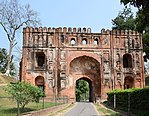This article has multiple issues. Please help improve it or discuss these issues on the talk page. (Learn how and when to remove these messages)
|
Malda district, also spelt Maldah or Maldaha (Bengali: [malda], [maldɔɦ], often [maldɔɦo]), is a district in West Bengal, India. It lies 347 km (215 miles) north of Kolkata, the capital of West Bengal. Mango, jute and silk are the most notable products of this district. The special variety of mango, Fazli, produced in this region is popularly known by the name of the district and is exported across the world and is internationally acclaimed. The folk culture of gombhira is a feature of the district, being a unique way of representation of joy and sorrow in daily life of the common people, as well as the unique medium of presentation on national and international matters. According to the National Investigation Agency Malda is believed to be a hub of a fake currency racket.[3][4][5] It is reported that 90 per cent of the fake currency that enters India originates in Malda.[6][7]
The headquarters of Malda district is in English Bazar, also known as Malda, which was once the capital of Bengal. The district maintains the traditions of the past in culture and education. Old Malda, the town which lies just east of the confluence of the Mahananda and Kalindi rivers, is part of the English Bazar metropolitan city. The town rose to prominence as the river port of the old capital of Pandua. During the 18th century, it was the seat of prosperous cotton and silk industries. It remains an important distribution centre for rice, jute, and wheat. The area between the historical monument of Jame Masjid (1566) and the landmark of Nimasarai Tower across the river Mahananda, constituted a municipality in 1867. Rice, jute, legumes, and oilseed are the chief crops in the surrounding area. Malda is the largest producer of excellent quality jute in India. Mulberry plantations and mango orchards also occupy large areas; mango trade and silk manufacture are the main economic activities.
- ^ a b "Fact and Figures". Wb.gov.in. Retrieved 5 July 2019.
- ^ "52nd Report of the Commissioner for Linguistic Minorities in India" (PDF). Nclm.nic.in. Ministry of Minority Affairs. p. 85. Archived from the original (PDF) on 25 May 2017. Retrieved 5 July 2019.
- ^ Malda, gateway of fake currencies. (14 September 2015). Times of India. Retrieved 12 March 2021.
- ^ "Malda, India's fake currency capital, is feeling the demonetisation pinch". 14 November 2016.
- ^ "Why does all fake currency come from West Bengal?". 25 June 2015.
- ^ "Malda Violence Was 'BSF Vs People', Claims Mamata Banerjee".
- ^ "Fake currency seized from Malda". 13 October 2015.






